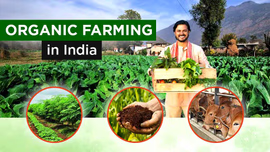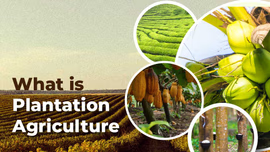Jute Cultivation in India – A Comprehensive Guide

Jute cultivation is an important agricultural activity in India, particularly in East India. It requires a warm and humid climate for better growth. West Bengal is the leading producer of jute in India.
Table of Contents
- Introduction
- Jute Cultivation in India
- Jute Farming Practices in India
- Major Jute Producing States in India
- Government Measures to Support Jute Farming
Introduction
Jute plantation has been in practice since ancient times. During the 19th and 20th centuries, its cultivation became indispensable due to its use in making sacks, boot lining, carpets, aprons, ropes, etc. The jute agriculture attracted people because of its properties like durability, versatility, strength, and low cost.
Jute crop is important cash crop of India. It is also known as golden fibre. It is the next important natural fibre crop after cotton in India. It is a 100% biodegradable crop.
Jute Cultivation in India
Jute is mainly grown in the delta region of the Ganges. That is why, the Jute cultivation in India is mainly concentrated in East India, particularly in the states of West Bengal, Assam, Bihar, Meghalaya, and Odisha.
Today, India is the largest producer of Jute goods globally. It contributes 70% to world jute production. According to the Ministry of Textile, the total jute production in 2022-23 stood at 9100 thousand bales (1 bale = 180 kg). Further, the total area under jute cultivation, as of November 2023, stood at 6.6 lakh hectares.
In India two major species of jute crop are cultivated. These are:
- White Jute: Its scientific name is Corchorus capsularis. This variety is used for making clothes, ropes, and twines.
- Tossa Jute: Its scientific name is Corchorus Olitorious. India is a leader in this jute variety. It provides fibre and its leaves are used for edible purposes. This variety is silkier, softer, and stronger than White Jute.
Jute Farming Practices in India
Jute farming in India requires specific climate, soil, and practices. Some of the practices in jute cultivation in India are sowing, irrigation, harvesting, and extracting jute fibres, among others. Let us see each practice briefly.
Climate and Soil Requirement for Jute
Jute crops are native to regions with warm and humid climates. The rainfall, temperature and soil needed for jute cultivation are:
- Rainfall required for jute is 2,500 mm.
- The temperature required for jute is in the range of 15 – 34° C.
- A mean relative humidity of 65%.
- Loamy and new grey alluvial soil of good depths with pH values of 5.0 – 7.4.
Sowing of Jute
The sowing time of jute varies from region to region. It depends on the amount of pre-monsoon shower received, availability of residual moisture in the soil, and the variety of jute species cultivated. But in general, sowing season of jute is from March – May.
Further, to sow the jute crops, either the line sowing method or broadcast method is used. But, due to several advantages of the line sowing method over the broadcast method, the former is largely used for jute farming.
In the line sowing method,
- First, prepare the land well until the soil has a very fine tilth. It requires ploughing and cross-harrowing 3 – 5 times followed by planking.
- Second, sow jute with a row spacing of 25 – 30 cm and plant spacing of 5 – 7 cm.
- Third, maintain a sowing depth of 2.5 – 3 cm.
Irrigation and Fertilizer Management of Jute
Jute cultivation requires a minimum of 50 cm of water and a soil moisture of 18 – 20% for its growth and development. The water needs are met either through rain or irrigation. Irrigation is especially required in areas with insufficient rainfall.
During the initial stages of growth, one or two irrigations at an interval of 20 days are required. This ensures that soil gets sufficient moisture which is very important for the germination of the jute seeds.
Fertilizer supplies essential nutrients for the growth of jute crops. Phosphorus, Muriate of Potash, Nitrogen, Urea, and Compost are used as fertilizers. Generally, white jute species require more nutrients compared to the tossa jute.
Jute Harvesting
The harvesting of jute can take place after 120 – 150 days from sowing of jute. The harvesting usually occurs in October. By then the jute crop starts shedding flowers. Ideally, the harvesting of jute crops at early stages gives the best quality fibre.
After harvesting, jute plants are left in the field for 2-3 days for the leaves to shed. Then, the plants are tied into bundles of 20 – 25 cm for soaking in water. Soaking is carried out just after harvest.
Jute Fibre Extraction
The fibre of the jute plant is under the bark, and it surrounds the woody central part of the stem. To extract jute fiber, usually two methods are used. These are:
- Single plant extraction method, and
- Beat-break-jerk method.
Further, the process to extract jute fibre involves the following stages:
Bundle Stalk à Retting à Strepping à Washing à Squeezing Access à Sundry à Bailing à Kutcha Packing à Storage/Transport
Major Jute Producing States in India
West Bengal is the leading producer of Jute in India and contributes 80% to the total jute production. The major Jute Producing States in India are:
|
States |
Production in 2022-23 (Thousand bales) |
Share in Total Production (%) |
|
West Bengal |
7580.3 |
83.3 |
|
Assam |
773.5 |
8.5 |
|
Bihar |
618.8 |
6.8 |
|
Meghalaya |
95.1 |
1.04 |
|
Odisha |
67.3 |
0.7 |
Government Measures to support Jute Farming
Indian government has taken several measures to promote jute cultivation in India. These are:
- Launched in 2015, the Improved Cultivation and Advanced Retting Exercise for Jute (Jute-ICARE) aims to double the income of jute growers.
- Central Research Institute for Research in Jute and Allied Fibres (CRIJAF) has developed SONA – a microbial consortium – to enhance the quantity of fibre yield by 20%.
- Government has fixed the Minimum Support Price (MSP) of raw jute at INR 5,335 per quintal for 2024-25 season.
Frequently Asked Questions On Jute Cultivation in India – A Comprehensive Guide
1. When is jute crop grown?
Jute crop can be grown from March to May.
2. Which soil is good for jute cultivation?
Loamy to alluvial soil is good for jute cultivation.
3. How is jute cultivated?
Jute in India is cultivated usually through line sowing method in which row spacing is 25- 30 cm, plant spacing is 5 – 7 cm and sowing depth is 2.5 – 3 cm.
4. Where is jute cultivated in India?
Jute is primarily grown in East India, particularly West Bengal, Bihar, Assam, Meghalaya, and Odisha.
5. Which soil is suitable for jute cultivation?
Alluvial or loamy soil are suitable for jute cultivation.
6. What are the favourable conditions for the cultivation of jute?
The favourable conditions for jute cultivation are warm and humid climate with no cloudiness during the growth of jute cultivation. Even waterlogging is a big no in jute cultivation.
7. How is jute crop harvested?
Jute fiber is harvested by cutting the stalks of jute plants close to the ground. After harvesting, the stalks are processed following a fibre extraction process of Retting a Strepping a Washing a Squeezing Access a Sundry a Bailing a Kutcha Packing a Storage/Transport.


Related Blogs












